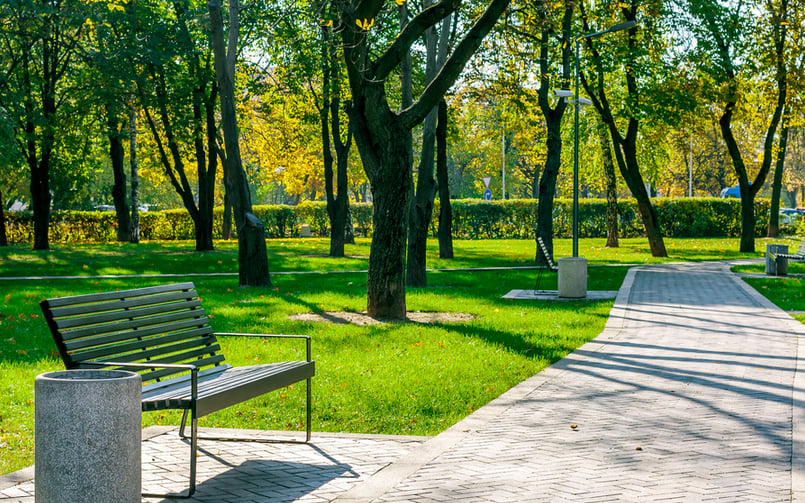Learn how some of the best landscape architects are turning ordinary spaces into superior city parks. There are many elements to creating a good neighborhood city park, from reducing noise pollution to forming a space that speaks to your community.
The Trust for Public Land uses a scale known as ParkScore to assess a region’s parks and green spaces. Scores increase for cities that offer adequate park acreage, along with access to recreational facilities and playgrounds. The maximum (best) score a city can receive is 100. The highest scoring city in the US is Minneapolis, which comes in at 81. The lowest scoring city is Fresno, at 27.5.
For a park to be considered ‘excellent’ it must meet the following qualifications outlined by the Trust for Public Land:
- The park has a defined and clear purpose
- Planning and community involvement is ongoing
- The park has adequate staffing, land, etc. to maintain goals
- Equal access for everyone
- User satisfaction is high
- Safety measures are enforced to protect people against crime and physical harm
- Green spaces offer benefits to the city that extend beyond the perimeters of the park
3 Secrets to a Successful City Park
1. Give it a Purpose that Fits with Your Community
Every urban community needs a green space they can escape to, and that space should speak to them. Think’s like an area’s demographics, weather, and culture should all play a role in the creation of a park’s primary goal and purpose. For instance, if your city is home to a lot of children, consider adding large playing spaces for soccer or Frisbee. For adults, incorporate walking or running paths. If there’s a large elderly community, perhaps you could add an outdoor Bingo area. A lot of young professionals in the area? Consider adding curb space for food trucks to line up.
Get creative, and don’t forget to speak with locals to find out what they want first-hand instead of guessing.
2. Tune Out the World, A Quiet Park is a Peaceful Park
Most urban parks are located beside loud industrial areas, busy streets and highways. So, how do you drown out the noise so it feels like a peaceful park? In the past, big landscape design firms have employed a host of unique methods to drown out the urban symphony of honks, horns, yells, and booms. If you don’t remove the noise, it makes it difficult for people to relax, enjoy themselves, or have a conversation. All in all, the buzz of a nearby bee should be audible, even in an urban park.
How Landscape Architects & Designers are Reducing Noise Pollution in City Parks
High frequency sounds, like tires rolling on pavement or a car’s roaring engine, increase when the source of the sound is within sight. Therefore, simply adding a barrier that interrupts the linear sight path can reduce noise pollution. For example, the landscape architect firm behind Brooklyn Bridge Park came up with the idea to add a berm, or a grassy hill that separates the park from the highway. That way, people standing next to the berm, where traffic noise would be highest, do not hear it as clearly because the berm stands in their line of sight.
Architects and designers had to be careful that this berm didn’t add more noise to the surrounding homes. They successfully managed to reduce noise in the park, while angling the berm to prevent it from reflecting the sound of the highway right back onto nearby houses.
Another way to drown out noise is to add a water feature. For instance, Paley Park is in Midtown Manhattan, which happens to be in one of the noisiest parts of the city. To drown out the noise, a 20-foot water wall was incorporated into the park’s design. Which just goes to show, sometimes the answer to reducing noise is simply adding another noise, albeit, a more peaceful one.
Designers have gone as far as to create a heat map of parks to indicate noise levels. From there, they can create a plan of action to reshape the land’s topography in a way that reduces noise. This also helps designers hand-pick quieter areas of the park to add benches for relaxing and tables for picnicking.
3. Use Long Lasting & Durable Materials to Reduce Park Maintenance
Don’t let the cost of park maintenance get out of hand! Employing long-lasting and durable materials makes a big difference regarding maintenance costs. From park benches and lighting fixtures, to planters and receptacles, TerraCast offers the longest lasting products on the planet.
The secret is in our specially formulated Linear Low Density Polyethylene (LLDP) resin. Plus, we manufacture our products right here in the USA with extreme attention to detail. Our planters, lighting fixtures, and site furnishings are resistant to graffiti, heat, cold, and even impact damage.

